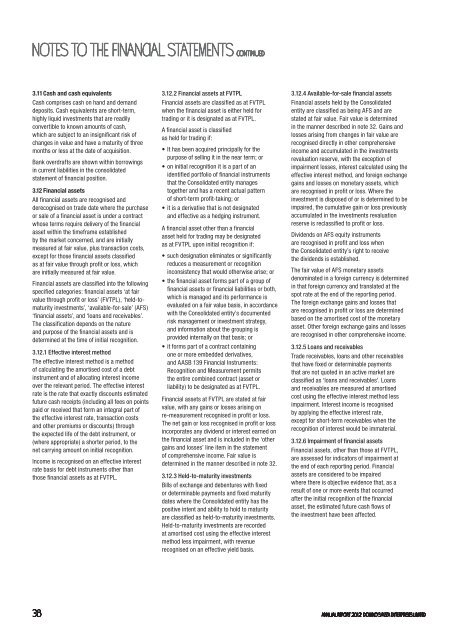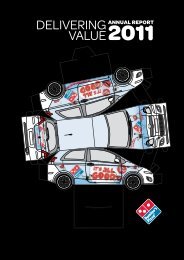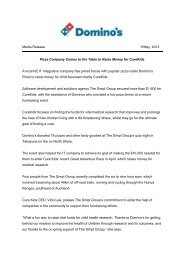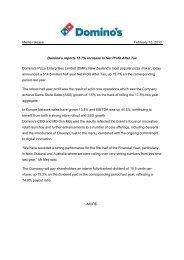2012 Annual Report - Domino's Pizza
2012 Annual Report - Domino's Pizza
2012 Annual Report - Domino's Pizza
You also want an ePaper? Increase the reach of your titles
YUMPU automatically turns print PDFs into web optimized ePapers that Google loves.
NOTES TO THE FINANCIAL STATEMENTS CONTINUED<br />
3.11 Cash and cash equivalents<br />
Cash comprises cash on hand and demand<br />
deposits. Cash equivalents are short-term,<br />
highly liquid investments that are readily<br />
convertible to known amounts of cash,<br />
which are subject to an insignificant risk of<br />
changes in value and have a maturity of three<br />
months or less at the date of acquisition.<br />
Bank overdrafts are shown within borrowings<br />
in current liabilities in the consolidated<br />
statement of financial position.<br />
3.12 Financial assets<br />
All financial assets are recognised and<br />
derecognised on trade date where the purchase<br />
or sale of a financial asset is under a contract<br />
whose terms require delivery of the financial<br />
asset within the timeframe established<br />
by the market concerned, and are initially<br />
measured at fair value, plus transaction costs,<br />
except for those financial assets classified<br />
as at fair value through profit or loss, which<br />
are initially measured at fair value.<br />
Financial assets are classified into the following<br />
specified categories: financial assets ‘at fair<br />
value through profit or loss’ (FVTPL), ‘held-tomaturity<br />
investments’, ‘available-for-sale’ (AFS)<br />
‘financial assets’, and ‘loans and receivables’.<br />
The classification depends on the nature<br />
and purpose of the financial assets and is<br />
determined at the time of initial recognition.<br />
3.12.1 Effective interest method<br />
The effective interest method is a method<br />
of calculating the amortised cost of a debt<br />
instrument and of allocating interest income<br />
over the relevant period. The effective interest<br />
rate is the rate that exactly discounts estimated<br />
future cash receipts (including all fees on points<br />
paid or received that form an integral part of<br />
the effective interest rate, transaction costs<br />
and other premiums or discounts) through<br />
the expected life of the debt instrument, or<br />
(where appropriate) a shorter period, to the<br />
net carrying amount on initial recognition.<br />
Income is recognised on an effective interest<br />
rate basis for debt instruments other than<br />
those financial assets as at FVTPL.<br />
3.12.2 Financial assets at FVTPL<br />
Financial assets are classified as at FVTPL<br />
when the financial asset is either held for<br />
trading or it is designated as at FVTPL.<br />
A financial asset is classified<br />
as held for trading if:<br />
• It has been acquired principally for the<br />
purpose of selling it in the near term; or<br />
• on initial recognition it is a part of an<br />
identified portfolio of financial instruments<br />
that the Consolidated entity manages<br />
together and has a recent actual pattern<br />
of short-term profit-taking; or<br />
• it is a derivative that is not designated<br />
and effective as a hedging instrument.<br />
A financial asset other than a financial<br />
asset held for trading may be designated<br />
as at FVTPL upon initial recognition if:<br />
• such designation eliminates or significantly<br />
reduces a measurement or recognition<br />
inconsistency that would otherwise arise; or<br />
• the financial asset forms part of a group of<br />
financial assets or financial liabilities or both,<br />
which is managed and its performance is<br />
evaluated on a fair value basis, in accordance<br />
with the Consolidated entity’s documented<br />
risk management or investment strategy,<br />
and information about the grouping is<br />
provided internally on that basis; or<br />
• it forms part of a contract containing<br />
one or more embedded derivatives,<br />
and AASB 139 Financial Instruments:<br />
Recognition and Measurement permits<br />
the entire combined contract (asset or<br />
liability) to be designated as at FVTPL.<br />
Financial assets at FVTPL are stated at fair<br />
value, with any gains or losses arising on<br />
re-measurement recognised in profit or loss.<br />
The net gain or loss recognised in profit or loss<br />
incorporates any dividend or interest earned on<br />
the financial asset and is included in the ‘other<br />
gains and losses’ line item in the statement<br />
of comprehensive income. Fair value is<br />
determined in the manner described in note 32.<br />
3.12.3 Held-to-maturity investments<br />
Bills of exchange and debentures with fixed<br />
or determinable payments and fixed maturity<br />
dates where the Consolidated entity has the<br />
positive intent and ability to hold to maturity<br />
are classified as held-to-maturity investments.<br />
Held-to-maturity investments are recorded<br />
at amortised cost using the effective interest<br />
method less impairment, with revenue<br />
recognised on an effective yield basis.<br />
3.12.4 Available-for-sale financial assets<br />
Financial assets held by the Consolidated<br />
entity are classified as being AFS and are<br />
stated at fair value. Fair value is determined<br />
in the manner described in note 32. Gains and<br />
losses arising from changes in fair value are<br />
recognised directly in other comprehensive<br />
income and accumulated in the investments<br />
revaluation reserve, with the exception of<br />
impairment losses, interest calculated using the<br />
effective interest method, and foreign exchange<br />
gains and losses on monetary assets, which<br />
are recognised in profit or loss. Where the<br />
investment is disposed of or is determined to be<br />
impaired, the cumulative gain or loss previously<br />
accumulated in the investments revaluation<br />
reserve is reclassified to profit or loss.<br />
Dividends on AFS equity instruments<br />
are recognised in profit and loss when<br />
the Consolidated entity’s right to receive<br />
the dividends is established.<br />
The fair value of AFS monetary assets<br />
denominated in a foreign currency is determined<br />
in that foreign currency and translated at the<br />
spot rate at the end of the reporting period.<br />
The foreign exchange gains and losses that<br />
are recognised in profit or loss are determined<br />
based on the amortised cost of the monetary<br />
asset. Other foreign exchange gains and losses<br />
are recognised in other comprehensive income.<br />
3.12.5 Loans and receivables<br />
Trade receivables, loans and other receivables<br />
that have fixed or determinable payments<br />
that are not quoted in an active market are<br />
classified as ‘loans and receivables’. Loans<br />
and receivables are measured at amortised<br />
cost using the effective interest method less<br />
impairment. Interest income is recognised<br />
by applying the effective interest rate,<br />
except for short-term receivables when the<br />
recognition of interest would be immaterial.<br />
3.12.6 Impairment of financial assets<br />
Financial assets, other than those at FVTPL,<br />
are assessed for indicators of impairment at<br />
the end of each reporting period. Financial<br />
assets are considered to be impaired<br />
where there is objective evidence that, as a<br />
result of one or more events that occurred<br />
after the initial recognition of the financial<br />
asset, the estimated future cash flows of<br />
the investment have been affected.<br />
38<br />
ANNUAL REPORT <strong>2012</strong> DOMINO’S PIZZA ENTERPRISES LIMITED













